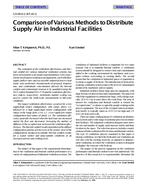Description
The evaluation of the ventilation effectiveness and thermal comfort for various industrial ventilation schemes has been carried out by scale model experimentation. Forty experiments involving ten ventilation arrangements, each with three supply airflow rates and two possible industrial process heat loads, were performed. Measurements of airspeed, temperature, and contaminant concentration allowed the thermal comfort and contaminant removal to be quantified using the ISO Comfort Standard ISO-7730 and the ventilation effectiveness indices, respectively. Archimedes number scaling was used to convert the small-scale measurements to full-scale conditions.
The largest ventilation effectiveness occurred for a low supply/high return configuration, with values above 1.6, followed by a high supply/high return configuration with values in the range from 1.0 to 1.2. A low supply/low return configuration had values of about 1.0. The ventilation efficiency generally increased when the heat load was increased and/or the flow rate decreased. Increasing the number of diffusers in the occupied zone increased the ventilation effectiveness. The thermal comfort results depended on the diffuser configuration and the activity level of the worker. Most of the configurations produced acceptable thermal comfort results for a seated worker and unacceptable conditions at an increased activity and clothing level.
Units: Dual
Citation: Symposium, ASHRAE Transactions, vol. 105, pt. 1
Product Details
- Published:
- 1999
- Number of Pages:
- 12
- File Size:
- 1 file , 1.8 MB
- Product Code(s):
- D-7573




